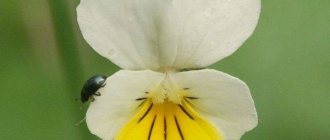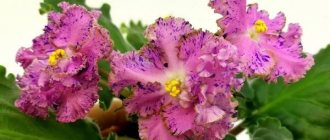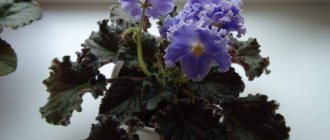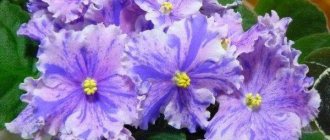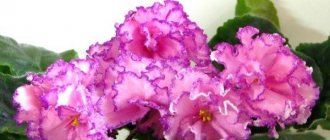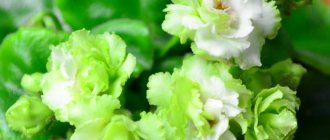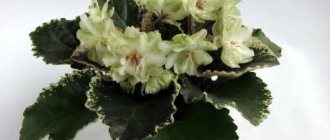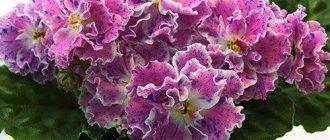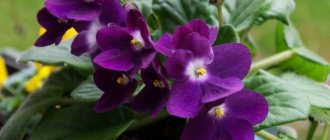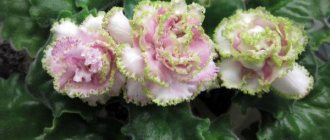Violet, description and photo of Dozhdinka (K. Morev)
Violets from breeders of the CIS countries - “D-2”.
Rain (K. Morev).
Large lilac-pink, deep-double stars with fringed edges and blue fantasy touches.
Dark green, shiny, quilted, rounded foliage. The leaves have slightly elongated petioles and bend slightly downwards. Small standard. A small, neat, regularly shaped outlet.
Double and semi-double flowers, lavender-pink background and blue fantasy splashes, like streaks of rain. There is a white border along the edge of the petals. There should be white shades on the petals. The flowers are large, about 6 cm in size. Each plant blooms differently.
As the rosette ages, the flowers become much brighter, darker and more fantasy. The color of the petals in daylight is bright and expressive, the border is clear. Towards the end of flowering the color fades a little. In hot weather, the border is weakly defined; in autumn it is brighter.
Blooms with a neat cap. It blooms almost without interruption, the flowers last a long time. The peduncles are rather weak and when there are a lot of flowers, they cover the rosette.
Grows and blooms quickly. It grows a little slowly during the transition from baby to starter, but then it blooms quickly. Sometimes gives blue sports.
Dozhdina is a raindrop.
Do you know that…?
When growing a two-color variety, you need to leave at least two rosettes in the collection and then, after waiting for flowering, choose the most beautiful one. If everything is in order, and the specimen has successfully repeated the required color, the size of the colored spot (as well as the size of the eye) may vary between different specimens - some are larger, some are smaller. In addition, the ratio of these two differently colored areas can vary during the life of one individual plant.
When violets are kept in excessively warm conditions, the border of the petals may well become thinner or even partially disappear. This phenomenon is usually temporary. The green or light green border turns white in unfavorable conditions, and the wide border becomes thin. In addition, similar properties of the border (width, green tint) may not be fully manifested during the first flowering, and only then are most expressed in mature, well-developed specimens.
Before you buy the violets listed below, carefully read the forums about their behavior on the windowsill. Many of them are very beautiful flowers. However, these can be large rosettes with large and fragile leaves, with leaves rising up or hugging the pot, forming many stepsons that interfere with the formation of a neat rosette, pulling the stem up and growing into a Christmas tree, bending the trunk, rare flowering with long breaks, fallen flowers or they last little and quickly wither, very long and recumbent peduncles, the color of the flower fades quickly, they do not like bright lighting on the windowsill, they are afraid of the slightest drying out or waterlogging, a large percentage of them go into sports or darken the flower.
Are they suitable for your window sill and the conditions that you can create for them? You will look at the flowers for several months, and the rosette will always be in front of your eyes. There are many beautiful flowers, there are much fewer beautiful and neat rosettes, look first at the rosette! Search and you may find a dozen violets with the same flower color if you are not interested in the smallest details as a collector.
• — Wedding Day (Lazarenko); • — Day by Day (Arkhipov); • — Curiosity (Morev); • — Brownie Kuzya (Burkatsky); • - Dulcinea (Prilutskaya);
March Rainbow: Dozhdinka (Morev), President (Makuni), EK-Lady Luck, EK-Magic of Love.
Found a mistake? Report it: 1) Select the error with the mouse 2) Press CTRL+Enter. Read more.
This is where my collection begins to bloom. I would like to show you a few violets that are currently blooming. I’ll start with the most, in my opinion, extraordinary one - Dozhdinka (Morev). The flowers are so huge that only two flowers fit on my straightened palm. Miracle variety!
Next of my favorites is President (Makuni). When this variety bloomed for the first time, I did not expect such an abundance of brightly colored flowers that attract the eye. This is the second flowering of my beauty. A “cap” is gradually formed, and very soon all the flower stalks will rise above the leaves.
And this is what she looked like a day later:
And now the primrose - EK-Lady Luck! Huge light pink flowers of a wonderful shade, lightly “powdered” with purple glitter. Along the edge of the petals there is a wide crimson-purple border.
And a closer look at the flower:
And another pretty variety, blooming for the second time; the peduncles, like soldiers, hold large double flowers with a white border. This is EK - Magic of Love:
The rest are still in buds. I'll wait for it to bloom.
Rain
Moderator: Floriana
Rain
Post by Inna S. » July 19, 2010, 2:21 pm
Saintpaulia Rain. Breeder K. Morev
Large lilac-pink, terry stars with fringed edges and blue fantasy touches. The leaf is dark green.
Re: Rain (Morev)
Post by Passific » 06 Jan 2011, 21:02
Dozhdinka (Morev)
Post by Selena » 06 Jan 2011, 21:12
Re: Rain
Post by Borisovchanka » July 31, 2015, 12:01
It's been a while since anyone showed anything in this thread. Here is my rain - the first flowering. I didn’t have time to take pictures right away - a brownish tint had already appeared around the edges of the flowers. But I'll show you anyway. Compact socket.
Re: Rain
Post by Ludok1976 » 05 Aug 2015, 21:19
Re: Rain
Post by Borisovchanka » 05 Aug 2015, 22:08
Re: Rain
Post by ROSA » 06 Aug 2015, 11:10
Re: Rain
Post by Natalya Shalamova » 06 Aug 2015, 14:41
Re: Rain
Post by Ludok1976 » 06 Aug 2015, 20:49
Re: Rain
Post by Ludok1976 » 06 Aug 2015, 20:50
All about Uzambara violets
Black violets
Calm, curious all the tones,
Wonderful is the night that is not completely black.
These black flowers are beautiful.
Breeders from all countries have been struggling for decades to create black flowers - roses, orchids, tulips. and of course the breeders did not ignore Saintpaulia. Black violet is for many breeders the pinnacle of their work. But unfortunately, pure black Saintpaulia cannot exist in nature. In living nature there is no pure black color, there is no enzyme responsible for this color. Black is the perception by the eye of dark shades, most often very rich brown, less often red or blue, dark purple, dark burgundy...
A large concentration of dark color in flowers leads to their rapid fading in the sun, that is, such flowers burn very quickly in the sun and literally burn out. This is not beneficial in nature, because the flower must have time to fulfill its function - pollination, but it will not have time to do anything. That's why there are no such flowers in nature. Another reason is that this color is not attractive to pollinating insects; they are simply not interested in such a flower. You can only make one or another shade saturated, bring it to a high concentration in the flower. But it will not be black, but very dark. red, blue, brown. And such a flower will not be very durable.
There is another way - to artificially color the plant. Yes, the color will be black, but this is a color and without a systematic infusion of dye it will dry out sooner or later.
All the research of breeders ends with only one thing - they bring the color intensity to the permissible maximum and our eye sees the color black, although in fact it is not so. Despite all of the above, “black” violets continue to fascinate, captivate and surprise.
Perennial violets - luxury in miniature
In recent years, the popularity of these tiny plants among connoisseurs of discreet natural beauty has increased incredibly. Perennial violets - heralds of the arrival of warmth - are liked by many summer residents. This is one of my granddaughter Liechka’s favorite flowers: every year, tired of the cold winter, we anxiously and impatiently await their bloom in early spring.
Perennial violets - heralds of the arrival of spring
Today you will meet the most beautiful species, among which the palm belongs to the fragrant violet. Nature has endowed it not only with luxurious tiny flowers, but also with a luxurious aroma.
Fragrant violet, photo by the author
I did not include the most famous violet (or Wittrock’s viola) with its numerous varieties in the post, because it is grown mainly as a biennial, despite the fact that it is a perennial plant. Therefore, our attention will be completely focused on the original perennial violets, which we plant in our dachas once, and they delight us for many years.
Perennial violet is hooked and curved. Photo from heritageseedlings.com
A huge variety of perennial violets have long been successfully grown in Europe and Great Britain; We will talk about some in more detail, while others you will see only in photographs.
Perennial Aetolian violet. Photo from greekflora.gr
Surely the unusualness of some species will surprise and amaze you as much as it did me when preparing the article.
Perennial Beckwith violet with unusual gray-pubescent leaves. Photo from botanikim.com
The similarity of the requirements of perennial violets for sun, heat, water, and soil allowed me to combine the features of their cultivation and use in dachas.
All about Uzambara violets
Black violets
Calm, curious all the tones,
Wonderful is the night that is not completely black.
These black flowers are beautiful.
Breeders from all countries have been struggling for decades to create black flowers - roses, orchids, tulips. and of course the breeders did not ignore Saintpaulia. Black violet is for many breeders the pinnacle of their work. But unfortunately, pure black Saintpaulia cannot exist in nature. In living nature there is no pure black color, there is no enzyme responsible for this color. Black is the perception by the eye of dark shades, most often very rich brown, less often red or blue, dark purple, dark burgundy...
A large concentration of dark color in flowers leads to their rapid fading in the sun, that is, such flowers burn very quickly in the sun and literally burn out. This is not beneficial in nature, because the flower must have time to fulfill its function - pollination, but it will not have time to do anything. That's why there are no such flowers in nature. Another reason is that this color is not attractive to pollinating insects; they are simply not interested in such a flower. You can only make one or another shade saturated, bring it to a high concentration in the flower. But it will not be black, but very dark. red, blue, brown. And such a flower will not be very durable.
There is another way - to artificially color the plant. Yes, the color will be black, but this is a color and without a systematic infusion of dye it will dry out sooner or later.
All the research of breeders ends with only one thing - they bring the color intensity to the permissible maximum and our eye sees the color black, although in fact it is not so. Despite all of the above, “black” violets continue to fascinate, captivate and surprise.
The nuances of growing perennial violets
These are mainly forest plants, for which shady and semi-shaded places in summer cottages are optimal, but they can also grow in well-lit areas. They love fertile loamy, moist soils, so caring for them is indispensable without watering. For more luxurious flowering, it is necessary to feed with complex mineral fertilizer (according to the instructions) during the budding period. When growing in vases, pots, containers, it is better to use a soil substrate consisting of humus, turf soil and sand, taken in a ratio of 2:1:2. Some varieties are suitable for growing in hanging baskets. Most species are winter-hardy in central Russia, but varietal varieties require light shelter for the winter.
Fragrant violet as a ground cover plant, photo by the author
In comfortable conditions, violets sometimes produce abundant self-seeding, which can be avoided by timely removal of faded flowers or seed pods. It must be remembered that some species are characterized by 2 types of flowers that produce many seeds: the main ones and the “last ones” (appear after the main ones, on short stalks, without petals). Violets are propagated by seeds during winter sowing and by dividing rhizomes in August-September.
Growing conditions
The growing conditions for this variety are listed below.
Priming
The plant variety in question is popular because, if you follow simple care rules, the plant can delight others with its flowering throughout the year. It is very important to choose the right soil mixture. Use light and loose soil. This will saturate the root system with oxygen. At the same time, the soil must retain moisture well.
Pot
It is necessary to grow the “Black Pearl” violet in pots whose height and diameter are 10 cm.
Moreover, ½ of the lower part should consist of drainage. Until the roots fill the container with soil, the violet will not bloom.
For breeding, the first pot can be 6 cm in diameter. In this case, the drainage hole should be large.
Lighting
In order for the violet to fully grow and develop, it is necessary to provide it with adequate lighting. To do this, keep pots with plants on the windowsill. Just make sure that direct sunlight does not penetrate it.
Temperature
To grow this variety of indoor plant, it is necessary to maintain a temperature regime of 20-24 degrees. If the temperature is 20 degrees, then adult specimens will bloom for a long time, and the flowers themselves will be large. For young plants that have just been separated from the mother leaf, it is worth setting the temperature regime to 23-24 degrees.
Humidity
Suitable humidity for violets remains 60-70%. If you exceed this figure, the crop may get sick and die
Using perennial violets in the country
Grown in the country as ground cover plants:
- f. fragrant;
- f. Labrador;
- f. white.
Grown as accent spots on the lawn:
- f. fragrant;
- f. Labrador;
- f. white;
- f. Altai;
- f. tiny.
Look luxurious in spring in rocky gardens:
- f. fragrant;
- f. Labrador;
- f. white;
- f. Altai;
- f. tiny;
- f. Manchurian;
- f. moth and others.
Fragrant violet among the stones.
Photo from the website swallowtailgardenseeds.com They feel great near ponds and bloom profusely:
- f. swamp;
- f. moth;
- f. bald.
A low border made of f. will be very cute and attractive. Labrador, or f. moth planted along the garden path leading to the recreation area. More refined and demanding types and varieties of violets are best placed in containers, wide low or high garden flowerpots.
Violet "Black Prince"
Saintpaulias are plants of the Gesneriev family, which we used to call indoor violets. They are very delicate and quivering flowers. Anyone who loves a violet will remain faithful to it forever. Each new variety is a discovery that evokes a passionate desire to grow a flower in your home. Today we will reveal all the secrets of the amazing variety of violets “Black Prince”.
Altai violet (Viola altaica)
It is highly frost-resistant and winters well in central Russia without shelter. This species first appeared in St. Petersburg at the end of the 18th century.
Altai violet. Photo from species.wikimedia.org
It comes from, as the specific name suggests, from the alpine zone of Altai, Sayan, mountains around Baikal, and Tien Shan. It is a rhizomatous perennial up to 20 cm high, the leaves are round or oblong-ovate, with a crenate edge, on long petioles. The flowers are solitary, blue-violet, with a yellow spot, white or cream, with blue stripes on the lower petals. In April it blooms for 40-45 days; repeated (but not as abundant) flowering can be observed in August.
Botanical description [edit | edit code ]
Perennial herbaceous plant, 20-40 cm tall. The rhizome is thick, woody, covered with rusty-brown scales. A stem with shortened internodes and a rosette of basal leaves develops after the first flowers appear. The basal leaves are entire, broadly ovate, with a kidney-shaped or rounded-heart-shaped base, with shallow notches along the edge, glabrous or slightly pubescent with short hairs, located on long petioles, with ovate-lanceolate stipules with an entire or notched-toothed edge.
Flowers are solitary. In spring, chasmogamous, mostly sterile flowers appear in the axils of the basal leaves. A little later, cleistogamous, fertile flowers grow on the stems that appear after the first flowers. Sepals 5, large, lanceolate, equal in length. The sterile flowers are zygomorphic (irregular) and have five light purple unequal free petals. The petals are rounded-ovate, the two lateral ones are pubescent at the base, inclined towards the lower petal, the lower petal is bare, larger than the rest, the upper two are bent upward. Cleistogamous flowers are small, inconspicuous, similar to unopened buds. There are five stamens. The ovary is superior, unilocular. The style is short, simple, the stigma is thickened, with a downward curved nose.
The fruit is a triangular, loculicidal (nest-bursting), naked, oblong-ovoid capsule, when ripe it opens with three valves and throws out seeds.
Flowering in April - June.
Fragrant violet (Viola odorata)
It is known that this particular species was introduced into culture in 1542 by monks in the territories of European monasteries. Currently it is called English violet, garden violet, and candy violet. She comes from Southern and Western Europe.
Fragrant violet, photo by the author
A rhizomatous semi-evergreen perennial 20 cm high and 30 cm wide, with a thick creeping rhizome, numerous rosettes of basal heart-shaped leaves, above-ground shoots rooting at the nodes, and single flowers up to 2.5 cm in diameter. Here, on the southern coast of Crimea, it overwinters without shelters while remaining green. Already in March, at my dacha it blooms with inky fragrant flowers on low (10-15 cm) peduncles. In central Russia, the main flowering occurs in April - May; a second wave may occur at the end of summer.
Decorative varieties:
- ' Christmas ' – white flowers;
Fragrant violet 'Christmas'. Photo from vivaipriola.it
- ' Coeur d'Alsace ' – pink flowers;
Fragrant violet 'Coeur d'Alsace'. Photo from vivaipriola.it
- ' Red Charm ' – red-purple flowers and others.
Fragrant violet 'Red Charm'.
Photo from the site vivaipriola.it The specific subtle and delicate aroma of fragrant violet is liked by many summer residents. Some ladies prefer to hear its notes at any time of the year in their favorite scents: “Champs-Elysees”, “Violette”, “Fidele Violette” and others.
Fragrant violet, photo by the author. Perfume "Champs-Elysees". Photo from the site royalparfums.com.ua
A long time ago, Parma violets were popular, and in winter they were everywhere driven out in greenhouses and hothouses. Their unique sweetish aroma belongs to the world-famous Parma variety of fragrant violet (Viola odorata var. parmensis).
History of the name
"The Black Prince" appeared in 2013. At its very first exhibitions, the new favorite created a sensation among violet lovers and collectors with its daring beauty. The noble and mysterious name of the flower fully corresponds to this beautiful plant.
“The Black Prince” is a real person, a legendary figure of the English Middle Ages - Edward Woodstock, Duke of Cornwall, Crown Prince of Wales. For his contemporaries he was a mystery. A talented commander, he could be both cruel and surprisingly wise, fair, hot-tempered and sentimental. In those harsh times, few of the royal dynasties allowed themselves to marry for love, but Edward did just that and remained faithful to his beloved to the grave. What was the reason for such an unusual nickname for Edward is unknown, but the wonderful Saintpaulia “Black Prince” is named in his honor.
Horned violet (Viola cornuta)
Especially loved in Europe. She comes from the highlands of France, Spain, and Italy. In culture since 1776
Horned violet. Photo from ru.wikipedia.org
It is a creeping rhizomatous evergreen perennial 15 cm high and 40 cm wide, producing dense mats. Violet, lilac, blue flowers with a small yellow eye and a characteristic horn-shaped spur bloom from May (mass flowering) and throughout the summer (single). Blooms profusely: 1 plant can have up to 60 flowers.
Horned violet 'Alba Minor'. Photo from gaissmayer.de
Decorative form:
- var. minor - up to 7 cm high, up to 20 cm wide, smaller flowers, 15-2 cm in diameter, from white to lavender-blue.
Planting and propagation
The Black Pearl violet reproduces by leaf.
To do this, you need to cut the leaf stalk with a sharp knife at a sharp angle. The length of the cutting is 3 cm. Water can be used to root the leaf. Pour it into a plastic or glass container, place ½ tablet of activated carbon there, and then install a leaf.
When the length of the root system is 1.5-2 cm, plant the leaf in peat, deepening it by 1 cm with an inclination of 45 degrees. Water thoroughly, cover with polyethylene and place in a bright and warm place.
Rooting of the leaf occurs within 2-4 weeks. Babies are formed in 1.5-2 months. All this time the leaf should be under polyethylene. Perform airing once a week, opening the film for 1-2 minutes. As soon as 2-3 pairs of leaves are formed on the children, then plant each one in separate containers, the diameter of which is 6-7 cm.
Care includes simple procedures listed below.
Watering
And although this plant variety responds positively to watering, you should not be too zealous.
Irrigate plants only with warm and settled water. When watering, do not allow water to get on the leaves, so it is best to water through a tray.
Spraying with a spray bottle is another great way to humidify as it will force water into the outlets.
Transfer
If the violet has stopped growing, then it is necessary to prepare a new pot, the diameter of which will be equal to 1/3 of the diameter of the rosette. The substrate also needs to be replaced. Since the root system of the plant is poorly developed, it should be replanted together with a lump of earth. Transfer the flower to a new pot and add substrate. All that remains is to water.
Fertilizer and feeding
To saturate the soil with necessary microelements and substances, it is necessary to apply fertilizer once every 2 weeks.
Make sure that the concentration of the solution does not exceed 2 g per 1 liter of water. To protect the plant from fungal infection, treat the soil with a weak solution of potassium permanganate.
Diseases and parasites
The “Black Pearl” violet is extremely rarely affected by parasites and diseases. This occurs mainly due to non-compliance with the rules of agricultural technology.
Table 1 - Flower diseases and treatment methods
Table 2 - Violet pests and their control
Dog violet (Viola canina)
Lovers of the landscape style of dachas will certainly appreciate this delicate violet. It comes from Europe and Western Asia.
Dog violet. Photo from naturalmedicinalherbs.net
This is a rhizomatous perennial 15-30 cm high and wide. Its blue flowers with a diameter of up to 2.5 cm are amazing. It blooms in May - June, sometimes again in August.
You can find interesting species and varieties of these charming little ones for sale using our market. View a selection of perennial violets and compare offers from different online stores.
Violet rarities
There are real “living jewels” among perennial violets. For example, a variegated beauty - Manchurian violet (V. mandshurica) ' Fuji Dawn '.
Manchurian violet 'Fuji Dawn'. Photo from davesgarden.com
Some violet lovers prefer varieties with variegated petals.
Violet with variegated petals, photo by the author
Beautiful violets with double flowers, like the variety f., are also quite rare. fragrant ' Flore Pleno '.
Fragrant violet 'Flore Pleno'. Photo from vivaipriola.it
Fans of ampelous species are already dreaming of Williams violet (Viola x williamsii) and its varieties ' Four Seasons ' (with fragrant flowers), ' Tiger Eye ' (with bright yellow flowers) and so on.
Williams violet variety 'Tiger Eye'. Photo from hedgerowrose.com
Among the fashionable violet novelties:
- sunny golden variety ' Beam Sunbeam ';
- sky blue ' Moonbeam's' ;
- mysterious dark ' Black Jack ';
- romantic lilac ' Purple Rain ' and others.
Also on the website, see materials about violets:
- Violet - a small autumn miracle
- Big-eyed prudes: what types of violets are in fashion today
- Such cute violets: types, varieties, hybrids
- Viola - the beloved granddaughter of the violet
Do you already have perennial violets in your dacha? Where do you use them, in what design element of the site?
Peerless violet Evdokia (NiL and RM)
The ancestral home of Saintpaulia is the mountainous regions of the eastern part of the African continent . Wild species of Uzambara violets can be seen along rivers, near waterfalls, in conditions of high humidity and mist.
Violet Evdokia has different flower colors.
After some time, the scientist Wenland studied and systematized the African violet. The botanist assigned them to a special genus , giving them a generic name in honor of the discoverer “Saintpaulia”. Below we will find out how the violet Evdokia (NiL and RM) blooms and develops.
Violet NiL Evdokia
Systematic position
The genus Saintpaulia hybrida belongs to the Gesneriaceae family of the order of dicotyledonous plants.
History of creation
The violet variety NiL Evdokia, the photo and description of which is presented below, was created by Ukrainian breeder Nina Levaya . Nina lives and works in Kyiv. He has been collecting since 1974. Selection of Saintpaulias - since 2008. Nina selects the following traits for her varieties:
Violet Evdokia was created by breeder Nina Levaya.
- Frequent and long flowering;
- Bright flowers;
- Strong peduncles;
- Unpretentiousness in maintenance and reproduction.
Description of appearance
The Evdokia variety has large flowers , up to 6 cm in diameter.
Round shape, simple. The color of the petals is fuchsia-pink, with a white-green fringe along the edge. The unopened flower has a fringe color of bright green, like duckweed. After opening, the fringe on the petals remains fragmented. The variety has strong peduncles. NiL-Evdokia blooms for a long time. The foliage is medium green in color.
Sports
One sport variety has been identified, differing from the source by the wavy edge of the leaf.
Features of flowering, growth and reproduction
NIL-Evdokia:
- Easy to take root;
- Grows quickly;
- Unpretentious.
The interval between rooting of a leaf cutting and the first flowering is usually 8-10 months . There are exceptions when the first buds open after six months.
The variety can
be propagated by :
The temperature in the room where violets of this variety live does not affect the appearance and quality of flowering. Naturally, if it is within 17-24 degrees .
Peduncles:
NiL-Evdokia loves to bloom. Already in the second flowering it will give a cap of bright, elegant flowers that will delight you for a long time.
Reviews
Violet Evdokia attracts many gardeners with its flowering.
Amazingly beautiful black flowers
Looking at the photographs, someone may ask: why are black flowers needed? Are there not many others - bright, jubilant, colorful, awakening the desire to live and create? To this one can object that black flowers are beautiful and literally enchant with their unusualness and mystery. It is not for nothing that breeders have been struggling for centuries to give the petals an impeccably resinous tone. Black mallow:
Kamchatka hazel grouse: The mottled coloration, from which the Russian name is associated, is clearly visible when the photograph is enlarged. In Latin, the flower is called more aristocratically - fritillaria.
Enchantress violets. He never lets go of his impenetrable black eyes, possessing a magical, bewitching power.
Picture of unique hyacinths. Sparing no time and money, enthusiasts worked for sixteen years to develop a variety that captivated flower lovers.
Siberian iris. A picture of a graceful flower colored with golden highlights. The low plant looks great in rockeries and mixborders.
The legendary flower, the hero of an adventure novel and real dramatic events. A non-trivial gift for an original and extravagant lover of beauty. Handsome black tulip.
Petunia with the name Black Night:
Black Orchid Tom Ford even named one of his fragrances, which is very popular, “Black Orchid”. In addition, director Brian De Palma also named his film the same way. In it, the girl was nicknamed the Black Orchid for her special beauty and passion for black clothes.
How many more mysterious, bewitching things Mother Nature conceals within herself!
(According to pages of articles from the Internet).
Mystical flowers,
The flowers are mystical and mesmerizing.
That's right, Lena! In our
That's right, Lena! In our family very often, in those distant years, we talked about the black tulip. Then a film about a black tulip appeared on the screens, but at that time selection had not yet been able to actually grow it. And now, looking at the miracles of selection, you get a fountain of joy. It’s like talking about blue roses – whether they really exist or not.
Exactly, I was just looking through
Exactly, just after looking at this article I remembered the story about the blue rose
Good day! How
Good day! As always, wonderful photos, still a rare black color. It would seem, well, how to convey a riot of colors through black. It turns out that it is possible, because it is the black color that gives flowers luxury, magic and admiration for the possibilities of nature! I saw black hollyhocks. and remembered another story. An old, very responsible Maria Romanovna worked as a janitor at our production site! And one day she sowed hollyhocks on our lawn - pink, lemon, red. Time passed, designs changed, tastes changed. Each time, various other flowers, exotic herbs and shrubs grew on the lawn. But every year, here and there, and even through the asphalt, Maria Romanovna’s mallows sprouted! And they bloomed almost all summer in memory of her!
Raya, thank you for the wonderful
Raya, thank you for the wonderful story and memory of a wonderful person.
Reminder for a newbie!
Uzambara (Uzumbar) violet is a plant of the Gesneriaceae family, growing in the natural environment of tropical and subtropical regions of Asia, Africa, Eastern Australia, South America and the Indian Ocean islands.
Saintpaulia is a plant named after the Saint-Paul father and son, who brought a plant unknown to Europeans from the Uzambara district (modern Tanzania) in the 19th century, presented for the first time at the international flower exhibition in Ghent in 1893.
Indoor violet has been one of the most popular plants in indoor floriculture since 1927. By 1949, more than 100 varieties had been bred, and today their number exceeds several thousand.
Rooting
- possibly in water, in substrate, moss.
Priming
- purchased soil or a mixture of leaf, coniferous, turf and peat soil in a ratio of 3:1:2:1 with the addition of raising agents (perlite, vermiculite, river sand, crushed sphagnum moss.
Lighting - it is best to place flower pots on western or eastern windows. To ensure that the plant is evenly illuminated from all sides, the pots are periodically rotated. In winter, when daylight hours decrease, you can use artificial lighting - fluorescent lamps.
Caring is a real art and serious painstaking work at the same time, including watering, fertilizing, and creating a favorable humid climate. Water Saintpaulias as the soil dries. The soil must be moistened regularly, but excess moisture should not stagnate in the roots. When watering, you must ensure that water does not get on the leaves. You cannot water the Uzambara violet with cold water. Fertilizing is done with complex mineral fertilizer once every two weeks. Saintpaulia reacts negatively to a lack of nitrogen in the soil. Optimal air humidity is approximately 50%, temperature is 20-22 ° C, without sudden fluctuations and drafts. The leaves of the plant should not touch the window glass. Removal of faded flowers and damaged leaves is carried out regularly.
Reproduction - planting a leaf cutting, part of a leaf, or a daughter rosette. The most popular method is rooting leaf cuttings. The formation of roots and the development of children lasts 4-8 weeks.
Pests are one of the gardener's problems. There are many different types of pests and it is very difficult to classify them. Among Saintpaulia pests, several groups can be distinguished: mites (spider mites, flat mites, transparent mites, etc.), insects (aphids, thrips, springtails, poduras, scale insects, whiteflies, scale insects, etc.), worms (nematodes).
Diseases - distinguish between infectious (gray rot, powdery mildew) and non-infectious diseases (rotting of the stem and root, wilting of the lower leaves, yellowing, leaf spotting, incomplete opening and premature drying, falling of flowers) of plants. The causative agents of infectious diseases are bacteria, fungi, and viruses. To prevent infectious diseases, you should strictly observe the regimes of watering, temperature, humidity, and lighting. Non-communicable diseases usually arise due to poor agricultural practices. They may appear in one instance and not spread to others.
Violet RM Evdokia (N. Skornyakova)
Systematic position
The genus Saintpaulia hybrida is part of the Gesneriaceae family. The Gesneriaceae, together with the Norichnikovaceae and the Yasnotkovaceae, form the order Lamiaceae .
History of creation
The world of flower growers learned about the existence of Saintpaulia at a flower exhibition held in Ghent in 1893.
It didn't take long for Uzambara violets to become a very popular indoor plant. Modern catalogs contain references to more than 30 thousand varieties of this plant.
Saintpaulia is very flexible, which allows you to develop more and more new varieties and varieties .
At the beginning of the 20th century, when breeding of Usambara violets was just beginning, their flowers were blue . Then varieties with white and purple flowers began to appear. After only 30 years of breeding, experts present varieties with double flowers. The selection of Saintpaulias is carried out not only according to the characteristics of the flowers; the shape and color of the foliage are very diverse.
The author of the RM Evdokia variety is Natalya Skornyakova, lives and creates new varieties in Kursk . The prefix RM in the names of her varieties are the initials of the breeder’s mother, to whom all of Natalia’s works are dedicated.
Description of appearance
The flowers of RM Evdokia are simple or semi-double, the edges of the petals are fringed. Pink-coral color with a bright blue-violet fancy pattern. Dark green foliage is collected in a neat rosette.
Violet RM-Evdokia has a very bright color of flowers.
Well, almost black violet Dark Night of The Soul
Speaking of almost black varieties, it is impossible to ignore the Dark Night of The Soul variety.
A beautiful, even, symmetrical rosette, semi-miniature in size , which forms independently. The leaves are variegated, rounded, and quite large. A special feature of the variety are spoon-shaped leaves, the edges curl slightly upward. The color of the leaves is variegated, medium green with white.
The flowers are wine-black, double pansies with a coral-red underside. In bud, the half-opened flower is almost black , but as it opens it acquires a red, rather beet-like, hue.
